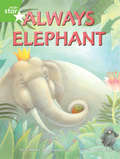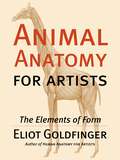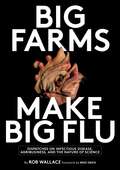- Table View
- List View
What The Animals Do and Say
by Eliza Lee FollenA charming piece of juvenile fiction, this work is informative as well as interesting. The engrossing narrative not only teaches children about wildlife but also conveys enduring moral lessons. With colourful imagery and captivating events revolving around the lives of various animals and birds, this is an astounding work.
The Wind in the Willows
by Kenneth GrahameThe escapades of four animal friends who live along a river in the English countryside--Toad, Mole, Rat, and Badger.
Always Elephant (Rigby Star Guided #Lime Level)
by Geraldine MccaughreanEvery year, all the animals held a competition to see who would be their new king. It was called the Challenge. Everyone took part in the Challenge, but it was always Elephant who won, year after year.
Animal Anatomy For Artists (PDF): The Elements Of Form
by Eliot GoldfingerFrom the author of the classic Human Anatomy for Artists comes this user-friendly reference guide featuring over five hundred original drawings and over seventy photographs. Designed for painters, sculptors, and illustrators who use animal imagery in their work, Animal Anatomy for Artists offers thorough, in-depth information about the most commonly depicted animals, presented in a logical and easily understood format for artists--whether beginner or accomplished professional. The book focuses on the forms created by muscles and bones, giving artists a crucial three-dimensional understanding of the final, complex outer surface of the animal. Goldfinger not only covers the anatomy of the more common animals, such as the horse, dog, cat, cow, pig, squirrel, and rabbit, but also the anatomy of numerous wild species, including the lion, giraffe, deer, hippopotamus, rhinoceros, elephant, gorilla, sea lion, and bear. Included are drawings of skeletons and how they move at the joints, individual muscles showing their attachments on the skeleton, muscles of the entire animal, cross sections, photographs of live animals, and silhouettes of related animals comparing their shapes and proportions. He offers a new and innovative section on the basic body plan of four-legged animals, giving the reader a crucial conceptual understanding of overall animal structure to which the details of individual animals can then be applied. The chapter on birds covers the skeleton, muscles and feather patterns. The appendix presents photographs of skulls with magnificent horns and antlers and a section on major surface veins. Incredibly thorough, packed with essential information, Animal Anatomy for Artists is a definitive reference work, an essential book for everyone who depicts animals in their art.
Badger (Large Print)
by RnibThis image shows a badger from the side. Its head is on the right of the page and tail on the left. It has turned to face towards you, showing all its facial features. The badger has a white face with two black stripes that run from its rounded ears on top of its head, down across its eyes to its cheeks. Its nose and snout are pointed. To the left of its head is its short neck and sturdy body. It stands on four short legs, each with paws and claws. To the right of its body is the badger's short tail.
Badger (UEB Contracted)
by RnibThis image shows a badger from the side. Its head is on the right of the page and tail on the left. It has turned to face towards you, showing all its facial features. The badger has a white face with two black stripes that run from its rounded ears on top of its head, down across its eyes to its cheeks. Its nose and snout are pointed. To the left of its head is its short neck and sturdy body. It stands on four short legs, each with paws and claws. To the right of its body is the badger's short tail.
Badger (UEB Uncontracted)
by RnibThis image shows a badger from the side. Its head is on the right of the page and tail on the left. It has turned to face towards you, showing all its facial features. The badger has a white face with two black stripes that run from its rounded ears on top of its head, down across its eyes to its cheeks. Its nose and snout are pointed. To the left of its head is its short neck and sturdy body. It stands on four short legs, each with paws and claws. To the right of its body is the badger's short tail.
Beetle (Large Print)
by RnibThis is a picture of a beetle viewed from above and facing the top of the page. There is a locator dot shown, which will be at the top left of the page when the image is the right way up. Just down the page, there is a silhouette of the beetle at approximately real size. In the centre of the page is the beetle's head with its mouth parts (palps) and two eyes. Its two front legs are to either side of the head. Further down, two more legs can be found on each side of the abdomen. Although this cannot be seen on this image, all of the beetle's six legs connect to the thorax, underneath its body. Its abdomen has a pattern of grooves running down it.
Beetle (UEB Contracted)
by RnibThis is a picture of a beetle viewed from above and facing the top of the page. There is a locator dot shown, which will be at the top left of the page when the image is the right way up. Just down the page, there is a silhouette of the beetle at approximately real size. In the centre of the page is the beetle's head with its mouth parts (palps) and two eyes. Its two front legs are to either side of the head. Further down, two more legs can be found on each side of the abdomen. Although this cannot be seen on this image, all of the beetle's six legs connect to the thorax, underneath its body. Its abdomen has a pattern of grooves running down it.
Beetle (UEB Uncontracted)
by RnibThis is a picture of a beetle viewed from above and facing the top of the page. There is a locator dot shown, which will be at the top left of the page when the image is the right way up. Just down the page, there is a silhouette of the beetle at approximately real size. In the centre of the page is the beetle's head with its mouth parts (palps) and two eyes. Its two front legs are to either side of the head. Further down, two more legs can be found on each side of the abdomen. Although this cannot be seen on this image, all of the beetle's six legs connect to the thorax, underneath its body. Its abdomen has a pattern of grooves running down it.
Big Farms Make Big Flu: Dispatches On Influenza, Agribusiness, And The Nature Of Science
by Rob WallaceThanks to breakthroughs in production and food science, agribusiness has been able to devise new ways to grow more food and get it more places more quickly. There is no shortage of news items on hundreds of thousands of hybrid poultry—each animal genetically identical to the next—packed together in megabarns, grown out in a matter of months, then slaughtered, processed and shipped to the other side of the globe. Less well known are the deadly pathogens mutating in, and emerging out of, these specialized agro-environments. In fact, many of the most dangerous new diseases in humans can be traced back to such food systems, among them Campylobacter, Nipah virus, Q fever, hepatitis E, and a variety of novel influenza variants. Agribusiness has known for decades that packing thousands of birds or livestock together results in a monoculture that selects for such disease. But market economics doesn't punish the companies for growing Big Flu—it punishes animals, the environment, consumers, and contract farmers. Alongside growing profits, diseases are permitted to emerge, evolve, and spread with little check. “That is,” writes evolutionary biologist Rob Wallace, “it pays to produce a pathogen that could kill a billion people.” In Big Farms Make Big Flu, a collection of dispatches by turns harrowing and thought-provoking, Wallace tracks the ways influenza and other pathogens emerge from an agriculture controlled by multinational corporations. Wallace details, with a precise and radical wit, the latest in the science of agricultural epidemiology, while at the same time juxtaposing ghastly phenomena such as attempts at producing featherless chickens, microbial time travel, and neoliberal Ebola. Wallace also offers sensible alternatives to lethal agribusiness. Some, such as farming cooperatives, integrated pathogen management, and mixed crop-livestock systems, are already in practice off the agribusiness grid. While many books cover facets of food or outbreaks, Wallace's collection appears the first to explore infectious disease, agriculture, economics and the nature of science together. Big Farms Make Big Flu integrates the political economies of disease and science to derive a new understanding of the evolution of infections. Highly capitalized agriculture may be farming pathogens as much as chickens or corn.
Black Widow Spider (Large Print)
by Rnib BookshareThis image of a Black Widow spider is viewed from above, with the spider facing up the page. There is a locator dot shown, which will be at the top left of the page when the image is the right way up. The spider's eight long, segmented legs stretch out across the page in all directions from the upper section of its body (cephalothorax) which is in the centre of the page. The lower part of the spider's small body (abdomen) is patterned, and is tucked between the lower pair of legs. Two mouth parts stick up from the upper part of the body, with a semi-circle of six small eyes just beneath them.
Black Widow Spider (UEB Contracted)
by Rnib BookshareThis image of a Black Widow spider is viewed from above, with the spider facing up the page. There is a locator dot shown, which will be at the top left of the page when the image is the right way up. The spider's eight long, segmented legs stretch out across the page in all directions from the upper section of its body (cephalothorax) which is in the centre of the page. The lower part of the spider's small body (abdomen) is patterned, and is tucked between the lower pair of legs. Two mouth parts stick up from the upper part of the body, with a semi-circle of six small eyes just beneath them.
Black Widow Spider (UEB Uncontracted)
by Rnib BookshareThis image of a Black Widow spider is viewed from above, with the spider facing up the page. There is a locator dot shown, which will be at the top left of the page when the image is the right way up. The spider's eight long, segmented legs stretch out across the page in all directions from the upper section of its body (cephalothorax) which is in the centre of the page. The lower part of the spider's small body (abdomen) is patterned, and is tucked between the lower pair of legs. Two mouth parts stick up from the upper part of the body, with a semi-circle of six small eyes just beneath them.
Blackbird (Large Print)
by Rnib BookshareThis is an image of a European blackbird viewed from the side and facing left so that only one eye and one wing can be found. There is a locator dot shown, which will be at the top left of the page when the image is the right way up. The blackbird has completely black plumage with grey legs, orange markings around its eyes and an orange beak. For clarity the plumage is brown on the Large Print version.nbsp;At the top left of the image the bird's head can be found, with its beak open to the left and one eye to the right. Right and down from this is one of the blackbird's wings and its long tail extending out to the right. The blackbird's two grey legs and feet can be found near the bottom centre of the page. Each has three toes pointing to the left and one to the right.
Blackbird (UEB Contracted)
by Rnib BookshareThis is an image of a European blackbird viewed from the side and facing left so that only one eye and one wing can be found. There is a locator dot shown, which will be at the top left of the page when the image is the right way up. The blackbird has completely black plumage with grey legs, orange markings around its eyes and an orange beak. For clarity the plumage is brown on the Large Print version.nbsp;At the top left of the image the bird's head can be found, with its beak open to the left and one eye to the right. Right and down from this is one of the blackbird's wings and its long tail extending out to the right. The blackbird's two grey legs and feet can be found near the bottom centre of the page. Each has three toes pointing to the left and one to the right.
Blackbird (UEB Uncontracted)
by Rnib BookshareThis is an image of a European blackbird viewed from the side and facing left so that only one eye and one wing can be found. There is a locator dot shown, which will be at the top left of the page when the image is the right way up. The blackbird has completely black plumage with grey legs, orange markings around its eyes and an orange beak. For clarity the plumage is brown on the Large Print version.nbsp;At the top left of the image the bird's head can be found, with its beak open to the left and one eye to the right. Right and down from this is one of the blackbird's wings and its long tail extending out to the right. The blackbird's two grey legs and feet can be found near the bottom centre of the page. Each has three toes pointing to the left and one to the right.
Blackbirds
by Gill Munton Ruth MiskinThese decodable non-fiction books provide structured practice for children learning to read. Each set of books is carefully levelled to match childrens growing phonic knowledge so children can read them with accuracy and fluency. The books cover the teaching of the Read Write Inc. Sets 1 and 2 sounds with topics including cooking and nature. The clear design helps children learn how to read non-fiction features including captions, labels and diagrams. The books are part of the Read Write Inc. Phonics programme, developed by Ruth Miskin. The programme is designed to create fluent readers, confident speakers and willing writers. It includes Handbooks, Sounds Cards, Word Cards, Storybooks, Non-fiction and Writing books and an Online resource for a fully integrated approach to teaching literacy. Read Write Inc. is fully supported by comprehensive professional development from Ruth Miskin Training to ensure its easy implementation.
Blue tit (Large Print)
by Rnib BookshareThis is an image of a European Blue Tit viewed from the side and facing left so that only one eye and one wing can be found. There is a locator dot shown, which will be at the top left of the page when the image is the right way up. The blue tit has distinctive and colourful plumage. It has a light blue 'crown' on top of its head, a white face with dark blue around it and a dark blue line going through its eyes. It has a yellow chest, green, blue and white wings and a blue tail. The bird is in the centre of the page. Its head is at the top centre with its small grey beak to the left and its eye to the right of this. Down the page is its chest on the left and wing on the right. At the bottom of the image are the bird's two grey legs, each with three toes pointing to the left and one to the right. Its small tail is on the right.




